TEN YEARS AGO TODAY: WE RIDE RYAN DUNGEY’S 2015 CHAMPIONSHIP KTM 450SXF

We get misty-eyed sometimes thinking about past bikes we loved and those that should remain forgotten. We take you on a trip down memory lane with bike tests that got filed away and disregarded in the MXA archives. We reminisce on a piece of moto history that has been resurrected. Here is our test of Ryan Dungey’s National Championship-winning 2015 KTM 450SXF. from the August 2015 issue of MXA.
“The early bird gets the worm.” That proverb proved true when we went on a quest to test Ryan Dungey’s Red Bull KTM 450SXF Factory Edition. The MXA wrecking crew is painfully aware that KTM has a corporate policy against allowing any tests of race bikes in the middle of a series, but we always ask, and Roger always says no. Then we ask again, and Roger wavers. Then we ask again, and Roger agrees; however, since Roger gets to choose the day when the factory team doesn’t need the bike, it almost always falls right in the gap between the AMA Supercross series and the AMA Nationals. This actually works out well for both of us, since we get to ride a works KTM at the start of the AMA National series, which then appears in an issue—in the middle of the 2015 AMA National series. Roger doesn’t break KTM’s corporate no-no, but we get to test the bike that Dungey is racing right now.
“THE EARLY BIRD GETS THE WORM.” THAT PROVERB PROVED TRUE WHEN WE WENT ON A QUEST TO TEST RYAN DUNGEY’S RED BULL KTM 450SXF FACTORY EDITION.
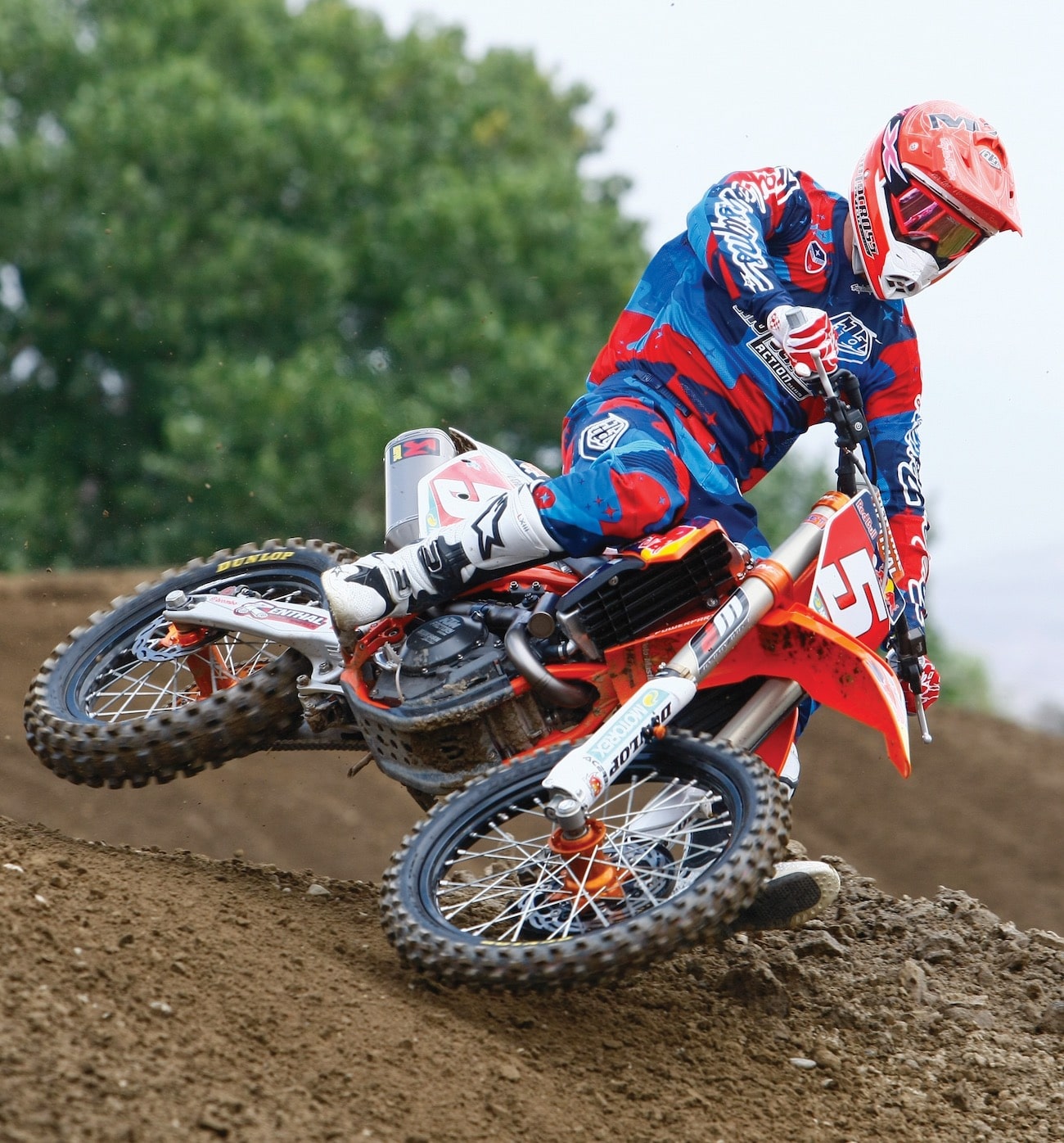
This leads us to Ryan Dungey’s KTM 450SXF outdoor bike. Even before Dungey blew out the candles in Las Vegas for his eighth Supercross win of the season, we were in Roger’s ear. He offered up Dungey’s title-winning Supercross bike, but we declined. Testing a Supercross bike would be an afterthought when the test came out. We wanted Ryan’s outdoor machine. DeCoster, a man who is truthful to a fault, wanted to shut us down because of the headache it would be to give us Dungey’s bike in the middle of National racing. But we were persistent, and after many conversations, we got our hands on Ryan’s works bike. When KTM’s Tom Moen and David O’Connor unloaded the bike for us on the appointed day, we gawked at the works parts, taking inventory of what was cool, unique and different from the standard Factory Edition. Below are the questions that you wanted to ask, along with the answers to those burning questions.
WHAT’S THE TRICKEST PART ON DUNGEY’S BIKE? Ryan’s mechanic, Carlos Rivera, filled us in on the trickery. We could go on and on about the specialty Met-Tek titanium fasteners that litter the 450SXF, the works Brembo brakes, titanium subframe or magnesium ignition cover. Certainly the engine internals, with the custom camshaft and titanium valves, would make any gear-head beam with excitement. For the MXA wrecking crew, it doesn’t get much better than the WP SXS Trax shock. It features not only high- and low-speed adjusters but is equipped with KTM’s unique dropout feature. Follow along as we explain the intricacies of a system that has been around for years but has been mostly an industry secret due to its stealthy appearance. What is a dropout shock? Internally, the shock speeds up the rebound when the rear wheel is off the ground in order to settle faster and allow the rear tire to maintain better contact with undulating terrain. As soon as the wheel leaves the ground, a valve opens to let the shock extend. It’s designed to work in small chop and braking bumps while still compressing fully and allowing the spring to take the brunt of force over large hits. The Trax shock system has been revised recently to allow the rider to “lock in” the dropout feature depending on the track. Dungey didn’t use the dropout in Supercross, because it had negative effects on the shock when clipping jump landings or under a heavy load. He is selective about which outdoor tracks to use it on, preferring the dropout design on tracks where traction is at a premium, such as Hangtown and Glen Helen.
 It’s hard to tell that behind the magnesium and aluminum is a powerplant that cannot be bought for any price.
It’s hard to tell that behind the magnesium and aluminum is a powerplant that cannot be bought for any price.
WHAT’S THE MOST UNIQUE PART ON DUNGEY’S BIKE? We were surprised to discover that Ryan Dungey uses a steering stabilizer; however, wipe any idea of a bulky and obtrusive Baja-style stabilizer from your mind. Instead, the KTM team uses a Honda HPSD stabilizer that comes stock on any late-model CRF250 or CRF450. Carlos Rivera mounts the upper stabilizer arm to a bracket located on the head tube, with the lower arm affixed to the bottom triple clamp. The 22mm Neken triple clamps with HPSD mounting post are designed especially for the team. Dungey runs solid, 40mm-tall bar mounts with a Renthal 821A FatBar. Known as the McGrath/Short bend, the 821 has very little sweep and sits low. The “A” is ever so slightly different from the standard 821 and is handpicked off the production line for Dungey. It is then marked with an “A” and sent to the Red Bull KTM team. A customer cannot buy the 821A, though it is so similar to the standard 821 that most riders wouldn’t notice a difference.
THEN AGAIN, WINNING EIGHT SUPERCROSS RACES AND FINISHING ON THE PODIUM IN ALL BUT ONE SUPERCROSS RACE WILL HAVE THAT EFFECT ON A RIDER.
HOW MUCH DOES DUNGEY’S BIKE WEIGH? We know what Dungey’s Red Bull KTM 450SXF Factory Edition Supercross bike weighed, because it was dangerously close to breaking the AMA’s mandatory weight limit. Carlos Rivera regularly weighed the KTM throughout Supercross to make sure that it was over the 220-pound limit. Carlos says that the weight fluctuated between 221 and 222 pounds, though at times it just passed by the skin of its shrouds. Why? To quote Rivera, “Depending on the Supercross track, sometimes the knobs would rip off in the main event, which dropped the overall weight of the bike.” Race teams are always searching for ways to lessen unsprung weight and get their 450 bikes close to 220 pounds; KTM has the opposite problem, thanks to its Factory Edition 450SXF.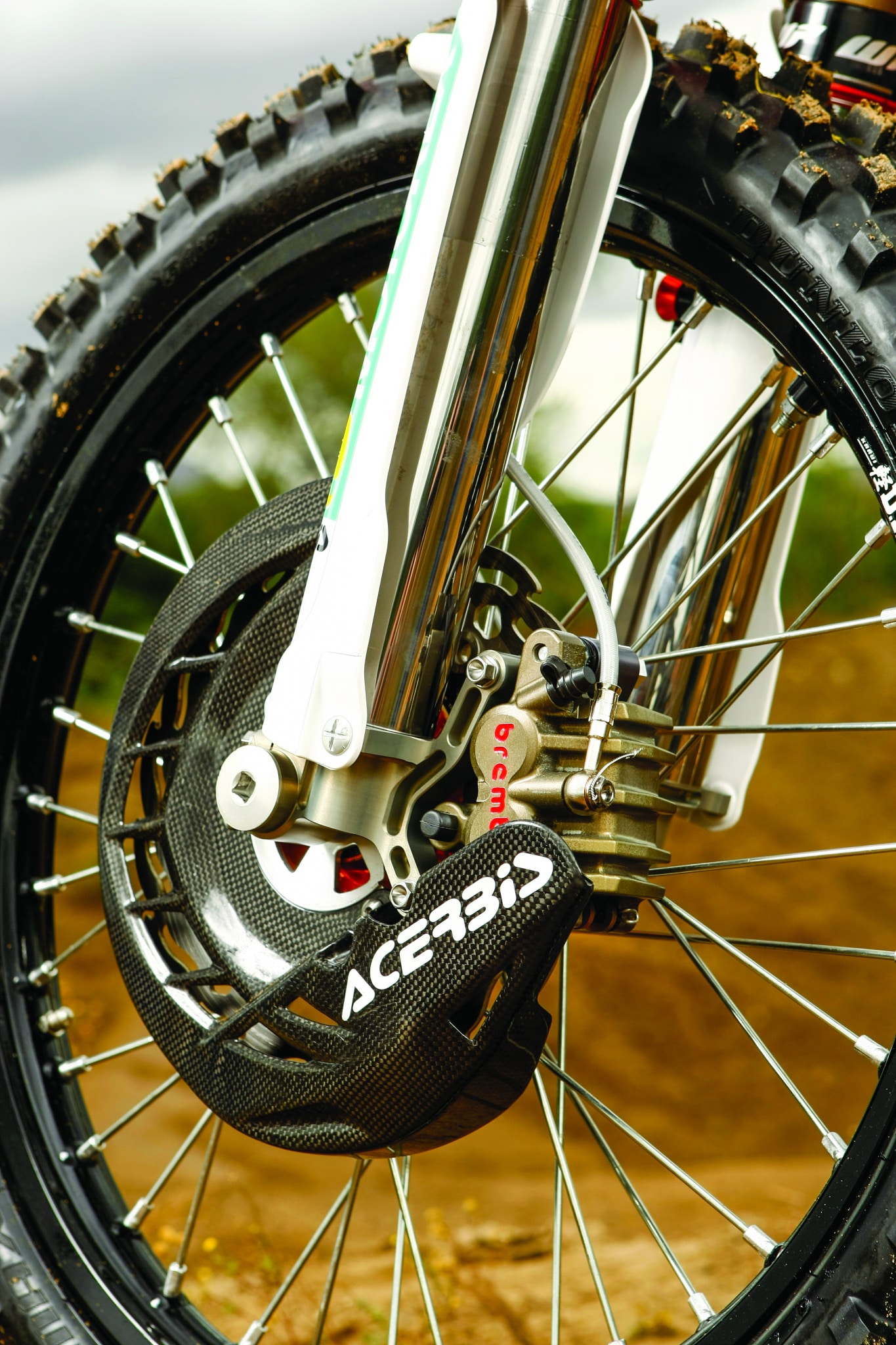 The Acerbis carbon fiber front brake cover was for protection, while the works Brembo caliper offered great modulation.
The Acerbis carbon fiber front brake cover was for protection, while the works Brembo caliper offered great modulation.
WHAT ARE THE DIFFERENCES BETWEEN DUNGEY’S SUPERCROSS AND OUTDOOR BIKES? Carlos Rivera was quick to point out the lack of major differences between what Ryan Dungey raced to the 2015 Supercross title and what he is riding in the 2015 outdoor series. Rivera says that Dungey was so impressed with the race package that he hasn’t varied much in bike setup over the course of the 2015 season. Then again, winning eight Supercross races and finishing on the podium in all but one Supercross race will have that effect on a rider. Dungey didn’t want to mess with success, despite the radical differences between Supercross and the Nationals.
Even so, it would be masochistic of Dungey to stick with the ultra-stiff suspension settings that he used indoors. For motocross, Ryan opens up the clickers and uses the morning qualifying sessions to find the sweet spot. He is constantly searching for a light feeling and balance between the forks and shock. That magic setting might be discovered after free practice or possibly not until before the second moto. Dungey, Rivera and the team are always trying to hit a moving target due to ever-changing track conditions.
Gearing is also an area of concern for Dungey. In Supercross, he typically ran a 14/52 sprocket combination. Outdoors, he switched to a 14/50 baseline setting and deviated from that depending on track conditions and altitude. Ryan likes a smooth powerband that doesn’t rip his arms out of their sockets yet still has gobs of power to secure the holeshot. His preferred outdoor gearing, along with a specialized engine configuration and camshaft tailored for Ryan, equates to a powerplant comparable to a turbo-diesel engine that winds out to 15,000 rpm. It isn’t the scary-fast, hard-hitting, explosive power you assume the champ would want.
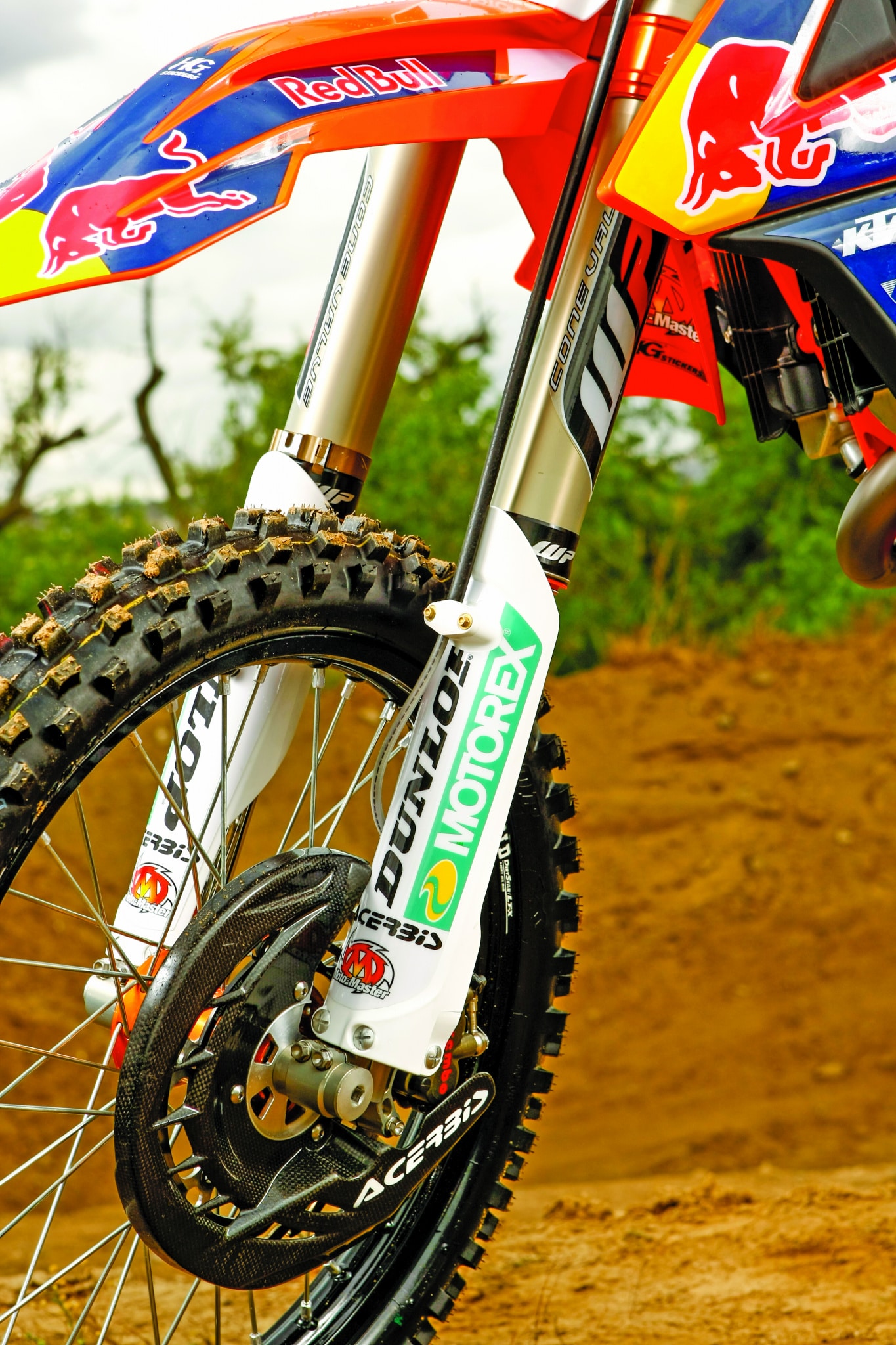 The 52mm WP Cone Valve forks were stiff in the initial part of the stroke but held up well for the fastest of the fast testers.
The 52mm WP Cone Valve forks were stiff in the initial part of the stroke but held up well for the fastest of the fast testers.
WHAT AREAS DID KTM FOCUS ON? It should go without saying that a powerful engine and suspension tuned to the rider are of utmost importance for any team to achieve success on the track; however, there’s an area of concern that is more crucial. A bike’s failure to withstand the rigors of racing is detrimental to the objective of scoring maximum points. The Red Bull KTM team took painstaking measures to ensure that a DNF didn’t happen. They asked Brembo to make aluminum plugs to replace the clutch cover and rear-brake master-cylinder sight-glass windows. The team discovered during testing that the sight glass had a tendency to crack from rock damage. These occurrences were rare, but KTM wasn’t taking any chances. Carlos Rivera also mounted an Akrapovic carbon fiber skid plate that protected the water pump and ignition cover from damage. A wraparound Acerbis carbon fiber front brake guard protects the Moto-Master Flame oversize rotor and bottom of the Brembo factory caliper. While carbon fiber is generally lighter than aluminum, it still adds weight to Dungey’s bike; however, the guards are insurance against disaster.
WHAT IS RYAN DUNGEY PICKY ABOUT? Aside from his suspension settings, specialty Renthal 821A FatBars and Renthal half-waffle soft grips, Dungey is not picky at all. We’ve ridden factory bikes that were set up so funky that they were nearly impossible to ride (we’re talking about Ricky Carmichael’s and James Stewart’s bikes). Dungey’s setup is middle-of-the-road. Carlos Rivera mentioned that Ryan is easy on the Hinson clutch and can go three races without burning up the rear brake pads. We did notice that the factory front brake and clutch levers were considerably thinner than standard levers and also had a dull sheen. Carlos admitted that it took three months and many tweaks before Dungey settled on his favorite lever shape. The billet-aluminum levers have the same leverage ratio as stock but are skinnier and lighter. Additionally, the brake lever is shorter so that Dungey doesn’t hook the lever on a hay bale when taking tight inside lines.
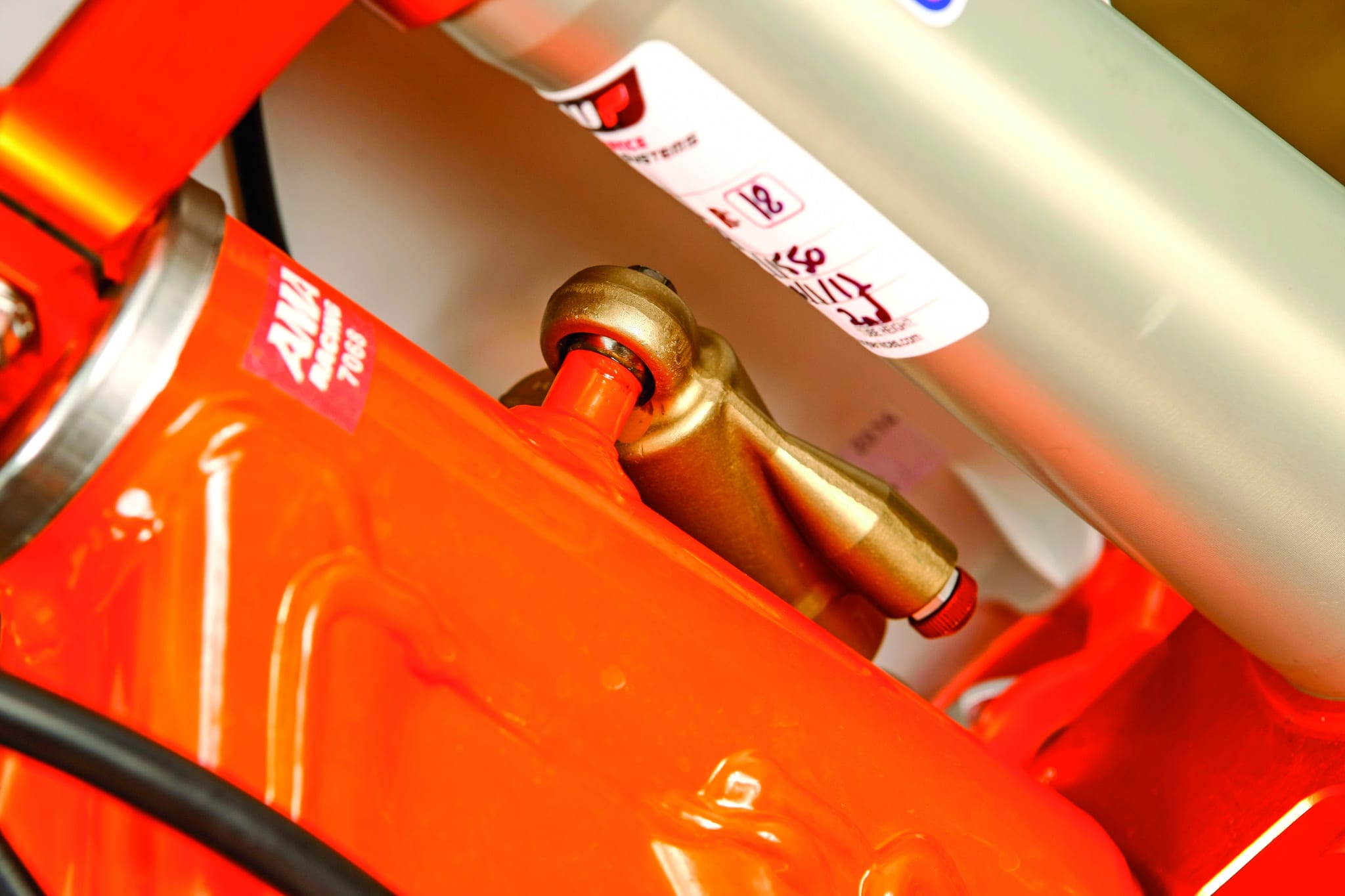 The Red Bull KTM team didn’t want anyone to know that Dungey used a Honda steering stabilizer.
The Red Bull KTM team didn’t want anyone to know that Dungey used a Honda steering stabilizer.
HOW FAST IS DUNGEY’S KTM 450SXF FACTORY EDITION? You would be surprised how effortless it was to ride Dungey’s bike. We’ve ridden factory bikes that were so wound up that the test riders needed a double shot of espresso before riding them. Not so with Ryan’s KTM. It was pleasant down low, smooth and efficient in the middle, and eye-wateringly fast at high rpm. How odd it must seem that a works engine would perform so beautifully for a wide range of skill levels. We could short-shift through the gears or lug the engine at will, and still the 450SXF wouldn’t quiver. It goes without saying that Dungey’s powerplant is best in the hands of a rider brave enough to let the engine breathe by twisting the throttle cable. Still, a fair number of slower testers remarked that they would be happy to race with Dungey’s engine‚ just as long as they could leave Ryan’s firm 52mm WP forks and Trax shock behind.
WHAT WAS DUNGEY’S SUSPENSION LIKE? MXA’s Pro-level tester hit the track first on Ryan’s 450SXF (that is the perk that goes with being fast). He pulled into the pits several laps later and asked if KTM had made a mistake with the suspension. His complaint was that the forks were far too stiff for motocross and must have been off Dungey’s Supercross bike. Tom Moen replied, “See that throttle? Twist it harder.” The MXA test rider nodded and went back out on the track and took Moen’s words to heart. Riding with newfound vigor, MXA’s Pro test rider pulled in again after a few laps, only this time he had a smile on his face. He discovered that the WP Cone Valve forks worked best when the bike was humming at full tilt, because the initial stiffness made way for mid-stroke plushness and incredible bottoming resistance. As fond as our Pro-level test rider was of Dungey’s suspension, slower riders didn’t stand a chance. They couldn’t go fast enough to break through the crust. The fork wouldn’t move unless significant force was applied.
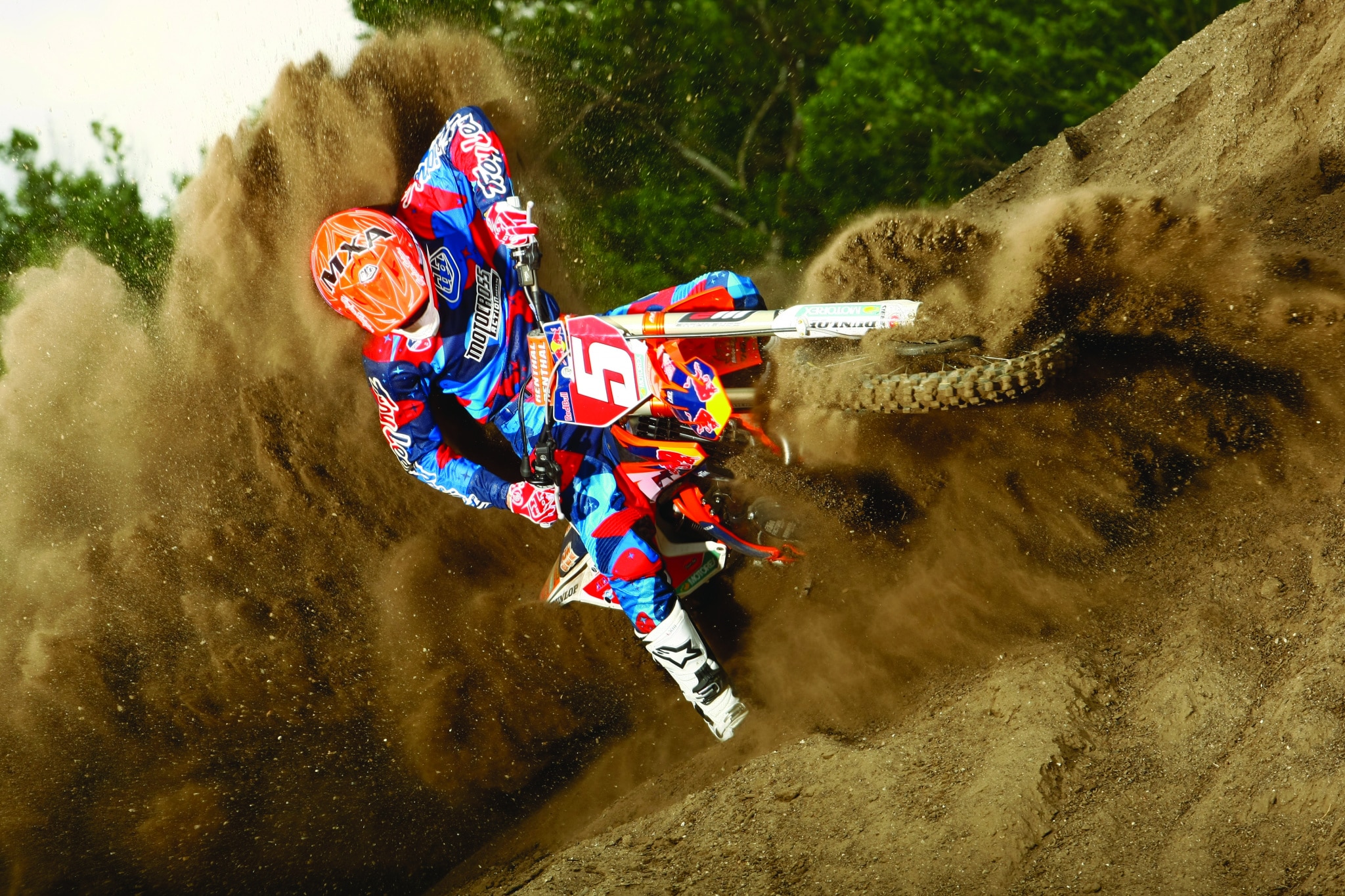 Pro-level test riders raved about Dungey’s suspension, while slower riders couldn’t get the forks to move; however, they all agreed that the powerplant was broad and usable.
Pro-level test riders raved about Dungey’s suspension, while slower riders couldn’t get the forks to move; however, they all agreed that the powerplant was broad and usable.
HOW DID DUNGEY’S BIKE HANDLE? MXA test riders are fond of how the new KTM 450SXF Factory Edition handles, but how would that chassis perform with ultra-stiff forks and a factory-tuned engine? It turns out that faster riders were very confident with the handling characteristics. They could dive inside on tight corners or carry speed around choppy outside berms without counter-correcting or backing off the throttle. The Honda HPSD damper eradicated any head-shake at high speed without making the front end feel weighed down. Slower testers noticed the handling benefits only in areas where the suspension‚ notably the forks‚ didn’t enter the equation.
WHAT DID WE REALLY THINK? Most riders would get lost in the works parts and excitement of riding a bike that only a very select few ever throw a leg over; however, the MXA wrecking crew has tested more factory bikes than Carter’s has liver pills. Amazingly, only a few stand out from the crowd, either due to the bike’s impressive performance or because it was nearly impossible to ride. Ryan Dungey’s KTM 450SXF Factory Edition outdoor bike is a rare member of the former group, because it offered something for everyone, not just the Champ.







Comments are closed.